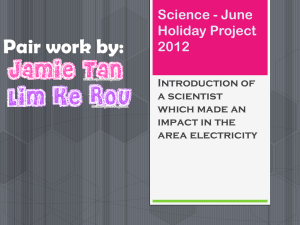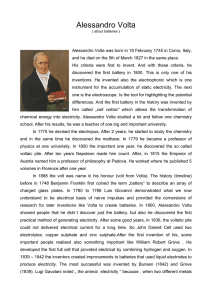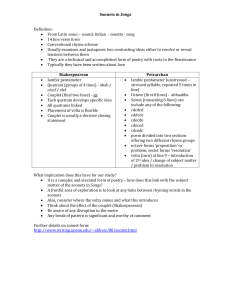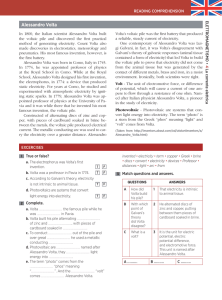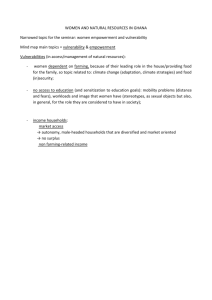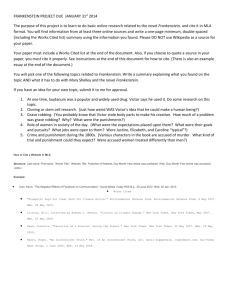Alessandro Volta and the Voltaic Pile
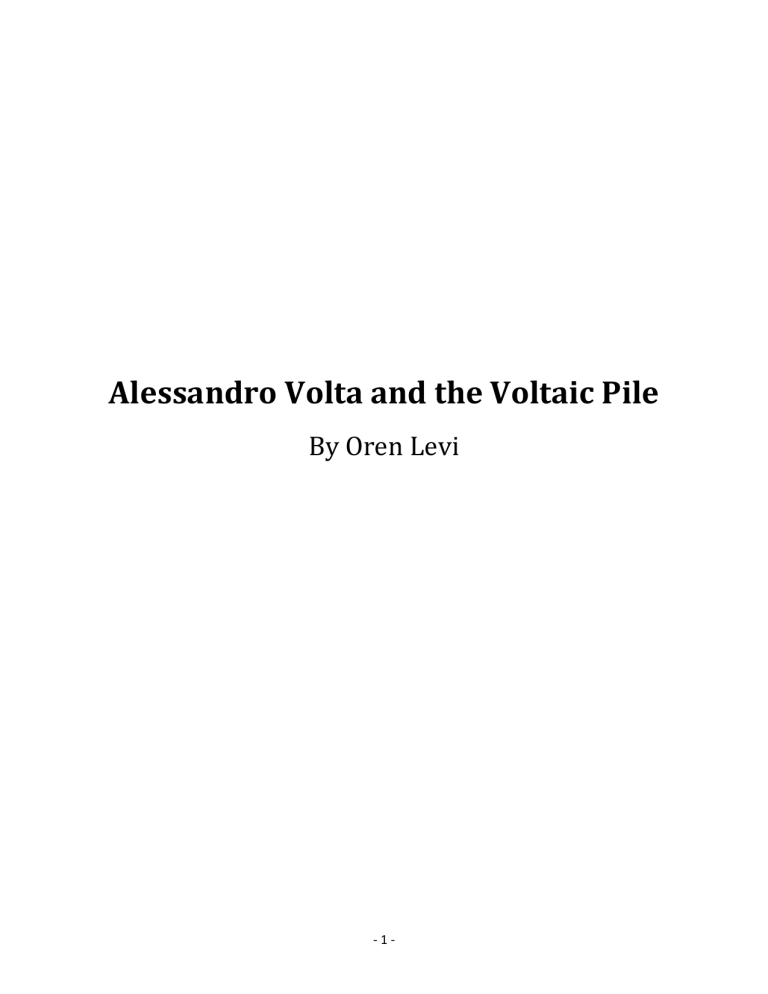
Alessandro Volta and the Voltaic Pile
By Oren Levi
- 1 -
Table of Contents
Timeline and ISLE Cycle……………………………………………………………………………………………….. p. 3
Biography: Alessandro Volta.………………………………………………………………………………….……. p. 5
Side story: Luigi Galvani and the Kicking Frogs………………………………………… p. 6
The Path to the Battery……………………………………………………………………………. P. 8
How The Electric Battery Works………………………………………………………………………… p.10
Lesson Tools:
Leiden Jar Activity…………………………………………………………………………………… p. 11
Electrophorus Project …………………………………………………………………………….. p. 13
Galvani Reading and ISLE Questions………………………………………………………... p. 15
Voltaic Pile Project………………………………………………………………………………….. p. 18
Reference Sheet………………………………………………………………………………………………… p. 21
- 2 -
History Leading to Volta’s Discovery of the Battery: ISLE Cycle and
Timeline
1745 : (A little over 10 yrs after Du Fay defined conductors and non-conductors) Ewald
Georg Voc Kleist and Pieter von Musschenbroek of Leiden independently create the
Leiden jar. (Also Alessandro Volta is born in Como, Italy.)
1746: Ben Franklin proposes the single fluid theory of electricity.
1752 : Ben Franklin conducts Kite experiment, proving that “atmospheric electricity” is the same as frictional electricity by drawing lightening down the wet string of his kite into a metal key and transferring the electricity from the key to a Leyden jar, with a silk string separating Franklin from the key. Franklin invents the lightning rod as a result.
1763 : Volta Proposes that electrical attraction followed from Newton’s laws of Gravitation.
Interactions between magnets and metal plates and filings shed light on the behavior of the electric fluid. Neither Franklin nor Nollet (French physicist in the Royal society with which
Volta corresponded regularly) had attempted to make this connection in the past.
1764 : (Observations) Experiments with Franklin Square and magnetic attraction led him to believe that there was a saturation point to which a loadstone could hold. Compared this with the electric attraction ability of the Franklin square.
1769 : Published his findings in two publications on the attractive (and therefore repulsive) force of the electric liquid. He questioned past attempts at explanations of electrical interactions, saying that none took into account interactions at microscopic levels.
1771 : Through observations of his interactions of charged bodies of different material and Based on the assumption that all electrical interactions can be described by the same law, he proposed the hypothesis that: “Any two bodies, having unequal amounts of electric fluid,
(and other conditions being equal, attract each other with a force proportionate to the imbalance between the two amounts of fluid.”
Also received a translated copy of History of Electricity, realizing that many experiments he had done and devices he had devised were not unique.
1775: Continuing his pattern of recreating experiments of past scientists looked at several apparatuses (similar to the Wimshurst machine) and proposed the use of cooked wood rather than glass to produce static charge. The most notable improvement
Volta made was on an object made of a conductor upper plate and a lower plate made of resin or glass.
Volta announced the Electrophorus, an improvement on other devices similar to it based on
- 3 -
observations from experiments with vitreous materials, said to generate sparks infinitely without charging.
1777:
Leaves to travel Europe and visit other prominent physicists.
1780 : Created the Condensatore, a device similar to the electrophorus which amplified the streangth of weak charges so they could be measured.
Luigi Galvani begins Observational experimenting with animal electricity when he observes a severed frog leg kick when brought in contact with an electrified probe and a scalpel. (See Galvani Reading and questions for separate Galvani ISLE Cycle)
1782: Volta created condensing electroscope (or “straw electroscope”) which used straws instead of gold foil and was scrupulously standardized and compared to other electroscopes of the time. It became the most sensitive indicator of charge .
1791 : Receives Luigi Galvani’s paper on the kicking frogs and proceeds to first agree, then disagree by observations of his own experiments. Volta disagrees with Galvani’s explanation that animals were a source of electricity.
1792-93: Volta begins to series of observational experiments with different metals. The experiments, unknown to him, are similar to those of Johann Georg Sulzer who was researching the physiology of taste and observes a sour taste when two metals were placed on either side of the tongue and the other ends of the metal were brought together.
1796-1800 : Tested each of the listed Metals and determined which yielded positive and negative charges when brought into contact.
In 1797 Volta Published list of metals that yielded best results in generating electricity through observational Experiments. He also observed that moisture was required at the junction of the two metals (or graphite) to generate electricity.
Volta continued perfecting technique, realizing that certain classes of liquids affected electric output as well. Volta applied these findings, realizing that if one were to stack the alternating metal with moist cloths between, the opposite ends of the pile discharged very strong positive or negative charges (by measuring with his gold foil electroscope). Thus the “Voltaic Pile” was proposed as an endless flow of electricity, eliminating the tedious repeated generation of sparks from laden jars and other apparatuses.
-This marks the apex of Volta’s career-
- 4 -
From that point on, Volta received numerous commendations and rewards for his discovery of an “endless” source of electricity. His works were published in 5 volumes in
1816 . Volta retired in 1819 and died in 1827 .
Biography
Alessandro Volta was born to a well-known family in Como in Northern Italy.
Despite Volt’s family’s nobility, due to his father’s inability to hold on to money, Volta grew up in moderate poverty. From an early age, Volta appeared slow to his family. Even by the age of four, he had not yet learned to talk. However, by the age of seven, he had experienced a growth in intelligence and was reported as being one of the brighter students in the class. The school which Volta attended was a Jesuit religious school. Volta’s family had a history of religion as can be seen from the occupations of his siblings. Three out of Five of his brothers became priests and two out of four daughters, nuns. However, like most adolescents, when told by his teachers to refrain from indulging in “bodily pastimes,” the 16 year old Volta ignored them utterly and was known throughout his young adult, and adult, life to attend mask and costume parties popular in that time.
This is fortunate for us as, due to his disinterest in religion, Volta veered in the direction of “Natural Philosophy.” He was even known to write poetry with scientific themes including chemistry and electricity. Alessandro Volta furthered his interest in natural philosophy, particularly electricity by reading works by prominent contributors to the subject including Benjamin Franklin, Abbe Antoine Nollet, and Giovanni Battista
Beccaria. After completing his studies in Como, he began concentrating all his efforts on the study of electricity. As he worked and came up with new ideas, he began corresponding with Beccaria and Nollet about his ideas, particularly the idea that the attraction felt by electrified objects could be modeled on Newton’s laws of universal gravitation. Volta received a mix of praise and criticism for his ideas from his correspondence with others, but for the most part people told him not to bother with it. The most useful advice he received was from Paolo Frisi who told him that he would be better off concentrating on scientific instrumentation, and less on controversial theory. Frisi also sent Volta a copy of
Joseph Priestley’s History of Electricity.
This led Volta to realize the many of the ideas he
- 5 -
had come up with in his studies were not entirely original and that others had independently come to similar conclusions.
With this new book in hand, Volta began reading and reconstructing many experiments others had conducted in the past. He made a habit of recreating experiments and making adjustments and taking new data and reaching new conclusions. One such device was what came to be known as the Electrophorus. This object consisted of a metal disk held by an insulating rod is placed on top of a charged resinous surface, typically wax or amber in Volta’s time. When the resin is rubbed with fur or a cloth, charges transfer to the surface of the resin. By placing the metal plate on the surface of the charged resin, it induces a charge in the metal plate (further explanation in the electrophorus project later).
In creating the electrophorus, Volta also realized that a similar technique could be used to create a more accurate electrometer. It was this device that began to gain Volta some notoriety. For the beginning of his career, Volta’s primary interest was creating more accurate methods for measuring charge, such as the straw electrometer and Condensatore.
With his new found fame, Volta began travelling across Europe, meeting with other prominent scientists of the time, Lavoisier, Laplace, Watt, and Lagrange to name a few.
IN THE MEAN TIME
Side Story: Luigi Galvani and the Kicking frogs
While Volta was traveling Europe, an interesting thing was happening in the lab of
Luigi Galvani. With the aid of his wife and nephew, he tested to see the effects of electricity on muscles and nerves. To do this, he had an electrostatic generator and a Leiden jar which he would charge and bring in contact with various points of severed frogs legs. In one such experiment, a freshly dissected frog was being prepared on a table which had on it the electric machine, though it was not in contact with the tray nor was the frog very close to the machine. Suddenly, one of Galvani’s assistants brought the scalpel into contact with one of the nerves on the frog and the frog suddenly convulsed. This reaction was brought to the attention of Galvani and it was realized that the convulsions only occurred when the scalpel touched the nerve and there was a spark from the machine, though not in contact by probe or otherwise, with the frog itself.
- 6 -
This immediately struck Galvani as odd and he proceeded to conduct several other observational experiments. Galvani hypothesized that the convulsions, which would occur when the frog was grounded and the circuit between the scalpel, frog, and ground, while the electric machine created sparks, were caused be the electrical state of the atmosphere.
To test this, Galvani speared the spinal column of the frog on brass hooks and brought them outside to see if atmospheric electricity would elicit similar effects. The test proved unproductive, as no response was observed in the frog. When, in an attempt to change the circumstances of the experiment and elicit a response, Galvani took a bent iron rod, touched one end to the brass hook and the other to the frog’s leg. As a result, the frog sprang into action. In further testing of this new outcome, Galvani brought the frog inside the house, insulated from the atmospheric electricity outside, and repeated the conditions of the experiment. Sure enough, the frog legs jumped again.
After much consideration, with slight bias towards a physiological explanation,
Galvani concluded that the reason for the convulsions in the frogs’ legs was because the legs themselves generated electricity, which traveled in a full loop when allowed by external paths comprised of different material. In 1791, Galvani published his findings and, as was customary at the time, sent copies to other scientists in the interest of receiving feedback and validation. One recipient of the paper was Volta. At the time, Volta was experimenting with using marsh gases and using a spark traveling through wires to ignite it, intending for this to be a signal or form of communication. When Volta received
Galvani’s paper, he proceeded to repeat the experiments himself, as was his practice since beginning his studies.
At first Volta agreed with Galvani’s conclusions. However, after further, more in depth experimentation, Volta came to a separate conclusion. He hypothesized that it was the contact of the different metals and the contact of the tips of those metals with the parts of the severed frog that caused the electricity and therefore the jump. When Galvani received this news, being a soft spoken man and not one to enter into conflict, as well as being saddened by the passing of wife, he simply took the information at face value, though still believing his explanation to be true. However, Galvani’s Nephew, Giovanni Aldini refused to allow anyone to question his uncle’s theory. Aldini continued to experiment with
- 7 -
his uncles theory, extending the effect beyond frogs legs moving on to severed cow parts and even, in a few macabre demonstrations, deceased prisoners. Aldini even showed that the frogs’ legs would jump when in contact with wires of the same material (though this would be shown to be an effect of the nerves at the site of the freshly damaged tissue firing signals years later). Aldini published these findings in a paper with the aid of his uncle
Galvani under a pseudonym. Volta, however, completely ignored all the work done by
Aldini and continued on the path of electricity generated by the contact of different metals.
The Path to the Battery
Volta, being a physicist, rather than a physiologist or anatomist, concluded that it was the contact of the two different metals that caused the frog legs to jump. In testing this, he conducted an experiment in which he took pieces of different metals, such as copper, zinc, lead, iron, and graphite (not a metal, but still showed promising results), placed one on top of his tongue and one below and brought their tips together. When he did this, he tasted a salty-sour taste. He reasoned that it was this that indicated the presence of a charge. Unbeknown to him, physiologist J.G. Sulzer conducted this same experiment years before in a study on the properties of the tongue in relation to taste. However, Sulzer suspected that the contact of the two metals created an internal vibration that reacted with the taste sensors of the tongue and created the sour taste.
Volta continued his experiments thoroughly, not only touching the metals to his tongu, but for example, having one end of one metal touch his tongue and the tip of the other touch his eye or his forehead. In both cases, when he brought the opposite ends together, he observed white spots in his vision, showing him that the electricity was stimulating the optic nerves. Then after a few more years of research involving his condensing electroscope, Volta realized that when the metals were brought together, one became positively charged and the other negatively charged. Also different combinations of metals resulted in a larger buildup of positive and negative charges. He published his results in 1797.
Along with this incredible find, Volta also found that electrical forces were generated when metals touched certain classes of liquids like acids and salt solutions. With this new observation, Volta experiments with placing cotton or leather pieces soaked in
- 8 -
various acids and found that this increased the effect of the two dissimilar metals. Finally, he found that the effect could be further increased by stacking these units on top of each other. Volta coined the new device the “pile.”
It is interesting to note that while doing this experimentation, Volta had no device to measure current strength resulting from the piles. All of his tests, like with the contact of dissimilar metals, were done using his senses. He would take leads from either side of the pile and touch them to different parts of his body and feel a tingling sensation. Unlike the
Leiden Jar, however, the sensation was a constant tingling, rather than a single shock. It is the intensity of this tingling that led Volta to conclude that stacking the units of the pile led to a stronger electric force.
Volta explained that the difference in charge between the two ends of the pile, caused the “electric fluid to flow” away from one side and be pulled to the other side, since the two sides had opposite charge. This “Electro-motive” force, as he put it, was what caused the charge to move only when a circle was completed. In 1800, Volta sent a communication to the Royal Society outlining his finding of a constant source of electric charge.
- 9 -
How the Voltaic Pile Works
The voltaic pile works as a result of several chemical properties and reactions. The first is oxidation, which occurs when the interaction between two chemicals causes one to lose electrons. The second is electronegativity, which is a chemical property which defines the ease with which an element will attract electrons.
We will consider a voltaic pile with a zinc and copper strip as the metals and a cloth or paper towel soaked in salt water. As the liquid in the soaked cloth between the metals oxidizes the zinc strip, zinc ions are given off into the electrolyte. This happens because due to zinc’s orbital structure, it would sooner give off ions (which are chemically stable) than take electrons away from the electrolyte, since its outer orbital is full. As a result of the buildup of electrons from the loss of Zn
++
ions, the zinc becomes negatively charged. These Zn
++ ions then travel through the electrolyte and, in the case of salt water, will bind to the now ionized chlorine atoms and form ZnCl
2
.
As for the copper, it becomes positively charged due to the constant loss of electrons to the hydrogen ions from the water in the electrolyte. However, copper is more electronegative than zinc, so, when the zinc and copper pieces are connected by a wire, the copper will immediately start attracting the excess electrons that have been building up in the zinc. The difference in charge of the copper and zinc pieces creates a potential difference which causes the electrons to flow from one to the other. This is what give the battery the ability to cause current to flow through a circuit.
- 10 -
Leiden Jar Project
Materials:
Film Canister
Medium or large paper clip.
Aluminum Foil
Scotch Tape
Prepare Canister: (Canisters better prepared before class).
Poke a small hole in the lid of the canister with the paperclip. Put a single strip of foil around the inside and outside of the jar and try to have as much of the foil in contact with the walls of the canister as possible (this will not be easy for the inside). Use scotch tape to secure the foil to the inside and outside of canister.
Unfold the paper clip in a similar way shown above. The part with the loop will go inside the canister.
The reason to extend the loop past the top is to make sure the loop is always touching the foil on the inside.
Use a source of static charge and run it along exposed part of paperclip While holding canister in your hand!
This is important as the contact of the outer foil with you causes the outside foil to accumulate a single charge, the one opposite of the foil inside, while the opposite charge is grounded to you. After a few passes of your source, the jar should be charged enough to elicit a decent shock.
Discharge your Leiden jar by touching a finger to the exposed part of the paper clip while touching the outside foil with the same hand or opposite hand.
- 11 -
How Does a Leyden jar work? (5-10 min)
On the picture below, draw the charge distribution as a result of a charged object coming in contact with the exposed lead of the wire. Try charging and discharging your Leyden jar using various charge sources in the room (Wimshurst machine, rods and cloth/fur, balloon and hair, etc.) To test if jar is charged, use “charge indicator” (scotch tape).
Answer: The charge of the source being used will end up on the inside foil. The outside foil will then have a potential difference induced in it, with the charge opposite that of the inside foil occurring on the side of the foil closer to the canister, while the charge the same as that of the inside foil will end up on the outside of the outer foil and will be taken away if the jar is grounded. Thus the foils inside and outside the canister will end up with opposite charges, causing a potential difference between the two and resulting in the shock which a connection is made between them.
- 12 -
Electrophorus Project (Time: 15-20 min)
3 Step Three: Briefly touch pan with finger 1 Step one: Charge Plate
2 Step Two: Place top flat on plate 4 Step Four: Remove finger and lift top
Once you figure out how to work the electrophorus, try to charge your leyden jar. This was the primary reason Volta invented the electrophorus, as an “endless” source of charge to experiment with.
- 13 -
1 Step one: Charge Plate
Electrophorus Project (Answer)
3 Step Three: Briefly touch pan with finger
2 Step Two: Place top flat on plate 4 Step Four: Remove finger and lift top
- 14 -
Galvani Reading and ISLE Cycle Questions (20 min)
- 15 -
16
1.
Galvani Reading Qustions
What was it that Galvani’s assistants observed by accident? What were the conditions that caused this to happen?
Galvani proceeded to do further experiments, realizing that when the scalpel was held by the bone handle, being very careful not to touch the blade, even in the presence of the “electric machine,” contact with the nerve yielded no contractions. A similar result occured when the nerve was prod ed with a glass rod rather than the scalpel. Galvani concluded that it was due to the contact of the scalpel which, through the holder, allowed electric charge to leak out of the frog to the ground. This was what gave Galvani the first inkling that there might be something inherently electric in the specimen.
Lets move on to Galvani’s second major experiment with the effects of electricity on nerves and muscles of frogs. At the time of Galvani’s kicking frog experiments, it was known, thanks to Benjamin Franklin, that “atmospheric electricity” or lighting was another manifestation of electricity. So in order to make sure his original assumptions were correct, he proceeded to see if “atmospheric electricity” would elicit the same reactions from the frog legs.
2. How did Galvani set up this next experiment. Take note of the materials used in the experiment. What assumptions did he make? What did he observe?
3. In order to fix this lack of a reaction, Galvani changed the position of the hooks and the bronze hooks where brought in contact with the iron trellice. What heppend when he did this? To what did he attribute this reaction?
4. How did he test these new findings? What did he conclude?
5. If you were Galvani, what conclusions would you draw from this last experiment? Do you agree or disagree with with Galvani?
17
Build a Voltaic Pile (30 – 40 min with explanations)
Materials:
Nickels
Zinc Pieces (1/2 in x1/2 in)
Zinc strips (3 in long)
Copper strips (3 in long)
Paper towel squares (wider than nickels and
Salt Water Solution
Multimeter
Lemon
LED (try to get low voltage and current LED’s)
Aluminum Foil Strips zinc pieces)
Rubber bands
1.
Begin by testing which configuration of Nickel, Zinc, and salt water soaked Paper towel give the highest voltage reading (you may have to go to a more sensitive setting on the multimeter). Draw your configurations and resulting Voltage below:
1. 2. 3.
∆V=__________________ ∆V=________________ ∆V=________________
2.
The Configuration with the highest difference in potential will be called one “unit.” Volta found that one could increase the amount of potential difference by combining several units together. How should this be done? Try combining the units in three different ways. What potential difference do you observe for each one? (Draw configurations and note Voltage)
1.Two units separated by salt 2. Two units stacked Zinc to 3.Two units stacked nickel to water soaked paper: zinc/Nickel to Nickel zinc
∆V=__________________ ∆V=________________ ∆V=________________
18
3.
Now that we know how to stack our units, we can create a working voltaic pile! Stack your units up and secure with rubber bands. Measure the output of your units. Is this enough to light the LED? If not, can you combine the piles together and light the LED? Record your observations and process below.
4.
In order to understand what is happening, let’s look at the Lemon Battery.
Cut small slits in the lemon about 2 in apart
Insert the long copper and zinc pieces, one in each slit
Measure the voltage.
We see that we have a voltage reading, meaning there is a current flow. This is what is happening:
The citric acid in the lemon oxidizes the zinc. This means that the zinc molecules are breaking off
++ from the larger piece, giving up 2 electrons and becoming Zn ion.
The result of the oxidation is the Zinc becomes negatively charged because of the accumulation of electrons left behind by the zinc ions.
At the same time, H
+ ions that come out of solution in the acid grab electrons from the copper piece, causing a lack of electrons and giving the copper piece an overall positive charge.
Therefore, when you connect a wire between the two pieces, a potential difference is established and the electrons are pushed away from the negatively charged zinc electrode and are attracted to the positively charged copper electrode.
This reaction will continue until the zinc is completely oxidized.
19
Draw reaction in picture
How does this apply in the case of the Voltaic Pile? Explain below on the single cell.
20
Bibliography
A Chronological History of Electrical Development.
(1946). New York: National Electrical
Manufacturers Association.
Dibner, B. (1952). Galvani-Volta: A Controversy that led to the Discovery of Useful Electricity.
Norwalk, Connecticut: Burndy Library.
Dibner, B. (1964). Alessandro Volta and the Electric Battery.
New York: The Moffa Press, Inc. .
Pancaldi, G. (2003). Volta: Science and Culture in the Age of Enlightenment.
Princeton, New Jersey:
Princeton University Press.
21
